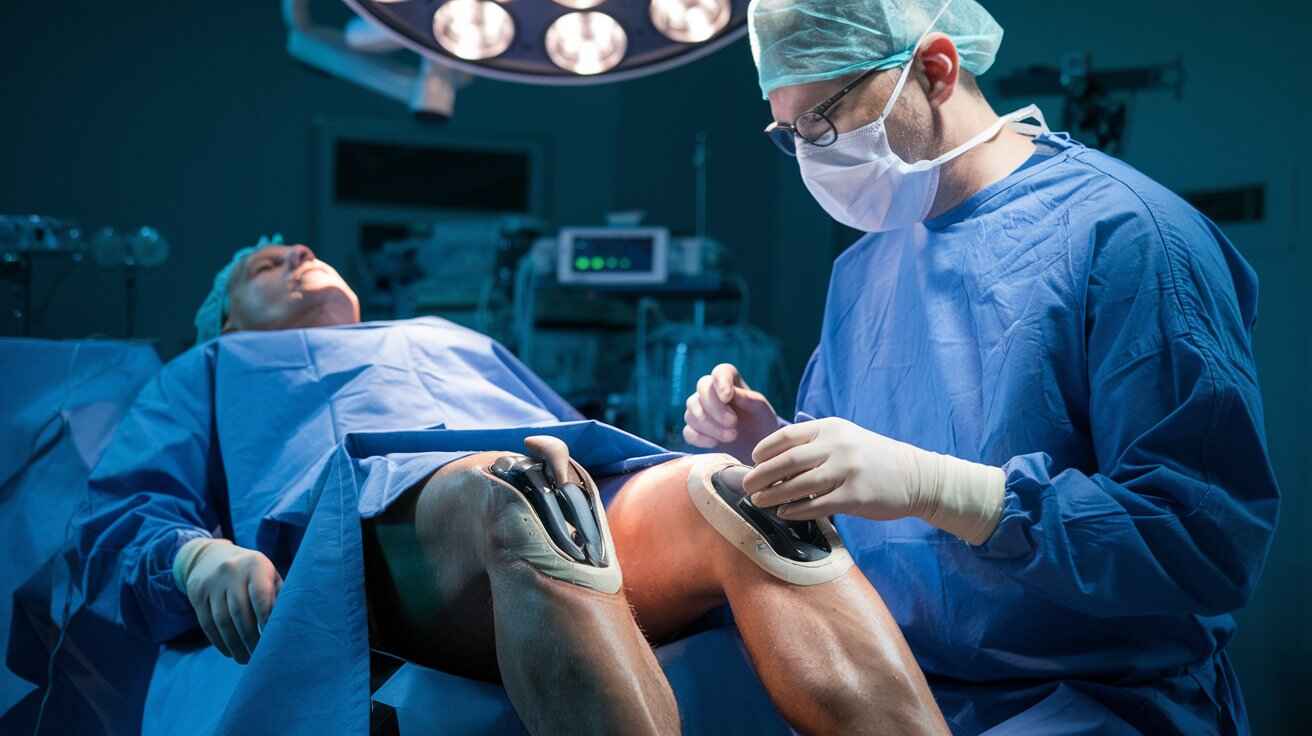Living with severe knee pain in both knees can significantly impact your quality of life. Simple activities like walking, climbing stairs, or even standing can become excruciating challenges. If you're facing this situation, you might be considering bilateral total knee replacement — a surgical procedure where both knees are replaced during a single operation or in close succession.
Dr. Debashish Chanda, an experienced orthopedic surgeon specializing in joint replacement surgeries, regularly helps patients navigate this important decision. This comprehensive guide will walk you through everything you need to know about bilateral knee replacement to help you make an informed choice about your treatment options.
What is Bilateral Total Knee Replacement?
Definition and Types
Bilateral total knee replacement refers to replacing both of your knee joints. There are two main approaches:
- Simultaneous bilateral knee replacement (also called "same-day bilateral"): Both knees are replaced during a single operation under one anesthetic session.
- Staged bilateral knee replacement: The knees are replaced in two separate surgeries, typically spaced several weeks to months apart.
The decision between these two approaches depends on various factors, including your overall health, age, medical history, and personal preferences.
When is Bilateral Knee Replacement Considered?
Not everyone with knee problems is a candidate for bilateral replacement. This procedure is typically considered when:
- You have severe arthritis or damage in both knees
- Conservative treatments like medication, physical therapy, and injections have failed to provide adequate relief
- Pain and mobility limitations significantly affect your daily activities and quality of life
- You're in reasonably good health without serious medical conditions that could increase surgical risks
The Bilateral Knee Replacement Procedure

Before Surgery
Prior to bilateral knee replacement, you'll undergo a thorough evaluation including:
- Physical examination
- Medical history review
- Blood tests
- Imaging studies (X-rays, MRI)
- Pre-operative medical clearance
- Medication review and adjustments
Your surgeon may recommend pre-operative physical therapy to strengthen muscles around your knees, which can facilitate faster recovery after surgery.
During the Procedure
Whether you're having simultaneous or staged surgery, the basic procedure for each knee is similar:
- Anesthesia: You'll receive either general anesthesia or spinal anesthesia with sedation.
- Incision: The surgeon makes an incision at the front of the knee, typically 6-8 inches long.
- Bone preparation: The damaged surfaces of the femur (thigh bone) and tibia (shin bone) are carefully removed.
- Implant placement: Metal components are positioned on the bone ends, with a medical-grade plastic spacer inserted between them to allow smooth movement.
- Testing and closure: The surgeon tests the new joint's function and range of motion before closing the incision with stitches or staples.
For simultaneous bilateral procedures, the surgeon typically completes one knee fully before beginning on the second knee, or may work with an assistant surgeon to reduce overall operating time.
After Surgery
Immediately after surgery, you'll be monitored in a recovery room before being transferred to your hospital room. Your care team will:
- Monitor your vital signs
- Manage your pain
- Help prevent complications with blood thinning medications
- Begin early mobilization, often getting you up and taking a few steps the same day of surgery
Simultaneous vs. Staged Bilateral Knee Replacement: Making the Choice
Benefits of Simultaneous Bilateral Knee Replacement
Single recovery period: One of the most significant advantages is going through the rehabilitation process just once instead of twice. This means:
- One hospital stay
- One anesthesia session
- One period of time away from work
- Overall shorter total recovery time
Cost efficiency: A simultaneous procedure often results in lower total costs compared to two separate surgeries. You'll have:
- One hospital admission fee
- Lower total anesthesia costs
- Potentially fewer therapy sessions overall
- Less time away from work
Balanced recovery: Rehabilitating both knees simultaneously often leads to more symmetrical strength and function, as neither leg can compensate for the other during recovery.
Risks and Considerations of Simultaneous Surgery
Higher initial physical demands: Recovering from surgery on both knees simultaneously is more physically challenging, especially in the first few weeks when:
- You have no "good leg" to rely on
- Getting in and out of bed requires more assistance
- Using the bathroom and other daily activities are more difficult
Potentially increased surgical risks: Some studies suggest a slightly higher risk of certain complications with simultaneous procedures, including:
- Blood clots
- Heart and lung stress
- Need for blood transfusion
- Extended hospital stay
More intensive rehabilitation requirements: The initial phase of physical therapy can be more challenging and may require:
- More assistance at home
- Longer inpatient rehabilitation in some cases
- Greater overall support from caregivers
Benefits of Staged Bilateral Knee Replacement

Lower immediate physical demands: Having a "good leg" during each recovery period makes many aspects of recovery easier, including:
- Walking with assistive devices
- Getting in and out of chairs
- Using the bathroom independently sooner
Potentially lower surgical stress: Dividing the surgical intervention into two procedures may reduce:
- Blood loss per procedure
- Anesthesia time per session
- Overall surgical stress on the body
Learning from the first experience: Patients often feel more prepared for their second surgery after going through the process once, which can help with:
- Managing expectations
- Preparing the home environment
- Planning effective pain management
Drawbacks of Staged Procedures
Extended total recovery time: Going through rehabilitation twice means:
- Two hospital stays
- Two recovery periods
- More total time away from normal activities
Delayed return to full function: The time between surgeries means longer before you can fully resume normal activities.
Possible compensation issues: During the period between surgeries, the unoperated knee may bear extra stress, potentially accelerating its deterioration.
Cost Factors for Bilateral Knee Replacement
The financial aspects of bilateral knee replacement vary widely depending on:
- Your insurance coverage
- Geographic location
- Hospital or surgical center chosen
- Type of implants used
Typical Cost Components
- Surgeon's fees
- Anesthesiologist fees
- Hospital or facility charges
- Implant costs
- Pre-operative testing
- Post-operative care and rehabilitation
- Medications
Insurance Considerations
Most health insurance plans, including Medicare, cover knee replacement surgery when medically necessary. However, coverage for simultaneous bilateral procedures can vary. Some insurers may:
- Cover both procedures at 100% of the allowed amount
- Cover the first knee at 100% and the second at a reduced rate
- Have specific requirements or limitations for bilateral procedures
It's essential to consult with your insurance provider before surgery to understand your coverage and potential out-of-pocket expenses.
Recovery After Bilateral Knee Replacement

Hospital Stay
Following bilateral knee replacement, you can expect:
- 2-5 days in the hospital (typically longer than for single knee replacement)
- Pain management through various medications
- Early mobilization with the help of physical therapists
- Education on wound care, precautions, and home exercises
Rehabilitation Process
Physical therapy is crucial for successful recovery and typically follows this progression:
Early phase (1-3 weeks):
- Basic knee range of motion exercises
- Walking with a walker or crutches
- Simple strengthening exercises
- Pain and swelling management
Middle phase (3-6 weeks):
- Advancing to a cane or walking unassisted
- More challenging strengthening exercises
- Improved balance activities
- Stair climbing practice
Later phase (6-12 weeks and beyond):
- Return to more normal daily activities
- Advanced strengthening and conditioning
- Sport-specific training if applicable
- Focus on long-term function and mobility
Timeline for Recovery Milestones
While everyone's recovery is unique, here's a general timeline of what to expect:
- 1-2 weeks: Basic mobility around the home
- 3-4 weeks: Decreased dependence on walking aids
- 4-6 weeks: Driving may be possible (if off pain medications)
- 6-8 weeks: Return to desk work or light duties
- 3 months: Significant improvement in strength and endurance
- 6-12 months: Continued gradual improvement and adaptation
Tips for a Successful Recovery
Home Preparation
Before surgery, prepare your home by:
- Arranging a temporary living space on the main floor if possible
- Removing trip hazards like rugs and cords
- Installing grab bars in the bathroom
- Obtaining assistive devices like a shower chair, raised toilet seat, and reaching tool
- Preparing meals in advance or arranging for meal delivery
Support System
Recovery from bilateral knee replacement requires more assistance than single knee surgery. Consider:
- Arranging for someone to stay with you for at least the first 1-2 weeks
- Coordinating family and friends to help with specific tasks
- Exploring home health care services if needed
- Investigating temporary rehabilitation facility stays if home support is limited
Pain Management Strategies
Effectively managing pain is crucial for successful rehabilitation:
- Take pain medications as prescribed
- Use cold therapy to reduce swelling
- Elevate legs when sitting or lying down
- Practice relaxation techniques
- Balance rest with regular movement
- Report any significant changes in pain to your healthcare provider
Frequently Asked Questions
Am I too old for bilateral knee replacement?
Age alone isn't a determining factor. Dr. Chanda evaluates each patient individually, considering overall health status rather than just chronological age. Healthy patients in their 70s and even 80s can be candidates for bilateral procedures when appropriate.
How long will my new knees last?
Modern knee implants typically last 15-20 years or longer. Factors affecting longevity include your activity level, weight, and how well you follow post-operative guidelines.
When can I return to sports after bilateral knee replacement?
Low-impact activities like swimming, cycling, and golf can usually be resumed around 3-4 months after surgery. High-impact activities like running and jumping sports are generally discouraged as they may shorten implant life.
Will I set off metal detectors with my new knees?
It's possible, though modern airport and security scanners are becoming more sophisticated. Carrying a medical implant card can be helpful, but most patients find that simply informing security personnel is sufficient.
What are the signs of potential complications I should watch for?
Contact your doctor immediately if you experience:
- Increasing pain or swelling
- Redness or warmth around the incision
- Drainage from the incision
- Fever above 101°F
- Calf pain or swelling
- Shortness of breath
Making Your Decision: Questions to Ask Your Surgeon
When consulting with Dr. Chanda or another orthopedic surgeon about bilateral knee replacement, consider asking:
- Based on my specific situation, would you recommend simultaneous or staged surgery?
- What is your experience with bilateral knee replacements?
- What complications have your bilateral knee replacement patients experienced?
- What type of implants do you recommend and why?
- What kind of pain management approach do you use?
- Will I need inpatient rehabilitation after surgery?
- How many physical therapy sessions will I likely need?
Conclusion
Bilateral total knee replacement can be life-changing for those suffering from severe arthritis in both knees. Whether you choose simultaneous or staged procedures depends on your individual health status, lifestyle needs, support system, and preferences.
Dr. Debashish Chanda is committed to helping patients make informed decisions about their knee health and achieving the best possible outcomes. Every patient's situation is unique, and the right approach is one that takes into account your specific circumstances.
If you're struggling with knee pain and considering bilateral knee replacement, schedule a consultation with Dr. Chanda to discuss your options and develop a personalized treatment plan.
Disclaimer: This article is for informational purposes only and does not constitute medical advice. Always consult with a qualified healthcare provider for diagnosis and treatment recommendations tailored to your specific situation.
Book a Consultation
Ready to discuss your knee replacement options? Call [PHONE NUMBER] or visit our appointment scheduling page to book a consultation with Dr. Debashish Chanda.
Have you or someone you know undergone knee replacement surgery? Share your experience in the comments below!






